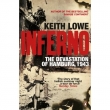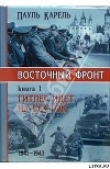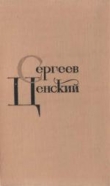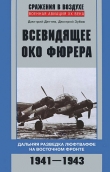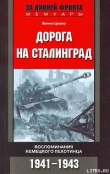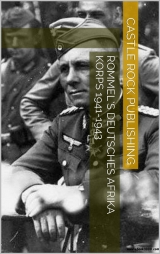
Текст книги "Rommel's Deutsches Afrika Korps 1941-1943"
Автор книги: Автор Неизвестен
Жанры:
История
,сообщить о нарушении
Текущая страница: 7 (всего у книги 19 страниц)
As night fell the German divisions settled down on the battlefield with 21st Panzer Division on high ground south of Sidi Rezegh and 15th Panzer Division south-west of Sciafsciuf. To ease Rommel's administrative and command problems Mussolini placed the Italian troops in the Marmarica under his authority. It remained the intention of the German commander to encircle and to destroy the British south of Sidi Rezegh and his orders for 23rd were that Ariete Division was to move at OS.OOhrs upon Gambut An hour earlier the German panzer forces, combining once again to form a solid armoured block, had also begun to move upon Bir el Gobi. By strengthening his left wing Rommel intended this to have sufficient force to encircle his opponents. To avoid the confusion which would arise through Ariete having British vehicles under command, the order was given that two white signal flares would be fired as the Axis recognition sign.
Some parts of 21st Panzer Division were retained to hold back the break-out attempts from Tobruk, while the remainder joined forces with 15th Panzer in its assault against Bir el Gobi. To form the western and northern sides of the ring the two Italian divisions Trieste and Pavia stood fast in their positions while to the east the German and Italian armour flung a noose around the British.
During the night, 5th South African Brigade attacked along the Trigh el Abd to the north of Bir el Gobi, while 13th Corps, in the course of its northern pincer drive moved a second New Zealand brigade up the Via Balbia towards Tobrnk and, this force coming across the tactical headquarters of the Africa Corps, attacked it dispersing part of it and pinning down anc isolating other sections temporarily from the main battle.
Sunday, 23 November dawned cold and very foggy, causing certain confusion among some of the units of 15th Panzer Division as they headed uncertainly in the poor light into what was the day of climax of the whole offensive. Within a few miles of the start of 8th Panzer Regiment's drive British tanks and vehicle concentrations had been met but the panzer group avoided a confrontation with these and struck south to take the British force in the flank. The 2nd Infantry Brigade and its anti-tank weapons were dropped off to form a gun line and to hold fast the British front while the mass of 15th Panzer Division carved its way southwards. It drove into a zone of artillery fire from guns which held position all round but, bursting through the hail of explosions, the columns concentrated, moved in towards the centre battalion, and, combining into a steel fist, struck at and through the British flank and rear areas, encountering and destroying in succession a supply column with its light armoured escort, 7th Support Group, and then 3rd Royal Tank Regiment which was on its way south to regroup.
Then the German front spread out again to cover a wider area and to drive before it, and, thus on to the guns of the other encircling units, the British formations which it met on its way. But the British were neither panic stricken nor incapable and flung in one armoured attack after the other in gallant, but un-coordinated assaults against the lunging German unit. From flank to flank the German anti-tank gunners were switched to hold the whole line of advance as 15th Panzer Division's left wing swung in a great steel scythe around the British flank and rear at Sidi Muftan.
Losses on both sides mounted as the British commanders realised the danger to their formations and flung in more units to hold back the German pincer. In the Bir el Halad area, held by 7th Support Group, the British commander formed a defence of successive anti-tank, tank and gun lines to defend his southern and south-eastern flank, and this aggressive defence forced 15th Panzer Division to swerve away and to seek a weaker spot along the flanks. From the east thrust the Germans and from Bir el Gobi the Italians, sending out armoured probing fingers. One of these found the boundary between 1st and 5th South African Brigades. The panzer group tore a gap between these Imperial troops through which reconnaissance detachments and armour poured, destroying as they advanced more British soft-skinned columns, then rolled up the flanks of the South African brigades and destroyed with artillery fire the concentration of British tanks which were assembling for fresh assaults.
But the helter-skelter advance of 15th Panzer Division had strung that force across the desert leaving it in isolated and unsupported groups. A halt was called to regroup; a short rest and then, towards midday, the attack rolled forward again still pursued and accompanied by British artillery fire. Just after midday at a point only 10 miles north-east of Bir el Gobi, white Verey lights shone in the sky to indicate that just ahead of the German panzer units lay the armoured fighting vehicles of Ariete Division. The ring, however loosely fitting, had been closed and imprisoned within it was the mass of 7th Armoured Division.
At 15-OOhrs and from the south came the main thrust upon the strategic Point 179 to drive 8th Army's armour on to the waiting gun lines of 21st Panzer Division. For the attack 5th Panzer Regiment was on the right and 8th Panzer Regiment on the left. These were reinforced with field artillery, whose principal task it was to support the infantry together with 18th Flak Regiment and their deadly 8.8cm guns, and followed by infantry from 90th Light Division. The German box poured up from the south but Ariete, which should have taken position on the left flank of the advance, arrived too late on the battlefield and took no active part in it.
The giant wedge of German armour-hurtled across the desert raising clouds of dust in its advance but was then struck by a hurricane of artillery and anti-tank gun fire which the British poured upon it. As the range decreased casualties inside the German box began to mount and on the sector where the anti-tank gunners of 5th South African Brigade held post the first wave of panzers was almost upon the slit trench line before the order was given tc open fire. Then the Boer gunners, working their pieces with frenzy, drove back the armour of 15th Panzer Division but it regrouped out of range and then came on again; but this time against a weaker sector of the line and forced a breach. Forward into the gap poured the riflemen of 115th Regiment but the Imperial infantry inflicted upon their officers and NCOs such losses that the attack halted and then receded as the German riflemen flooded back. The commanders and the staff officers reformed them and brought them forward again, up to, into, and then through the gap. The fighting became general and confused: infantry fought against infantry, tank versus tank, artillery battery against artillery battery. Attack was followed by counter-attack and then another attack as fighting swung first to the advantage of one side and then to that of the other. In vain did 22nd Brigade swing a left hook from the southeast; it was held, caught, and deflected with terrible loss. Carving its way through the British positions the 8th Panzer Regiment's 1st Battalion had, by 17:00 hrs, forced a salient 8 miles deep and then upon the aerodrome at Sidi Rezegh linked with the advanced elements of 21st Panzer Division. This was the killing thrust but the British and Imperial troops, fighting for their very existence, battled on. To the east vehicles of 5th Panzer Regiment then carried the advance forward to link up with 21st Panzer's left wing and then the intensity of battle began to die down leaving only 2nd Battalion of 8th Panzer Regiment still involved in beating back counter-attacks which were still beins mounted against it.
By 17:30hrs British resistance began to weaken and as darkness fell the whole area south of Sidi Rezegh was seen to be dotted with the fires of burning tanks and trucks. Explosions and shell fire lit momentarily the darkness under whose cover individual British vehicles and units were trying to storm their way through the Axis ring or to slip away and to make good their escape. The hours of darkness were used by both sides to regroup – a task made more difficult for the Axis troops than for their opponents for no wireless link had existed between Africa Corps headquarters and its subordinate units since the time that the New Zealand attack had dispersed it.
Only in the night as the regiments reported and as the exhausted soldiers unwound from the strain of battle did the realisation come that the Africa Corps, and indeed the whole Axis force, was fought out. The German units were jumbled up, fuel supplies had been totally consumed, ammunition had been fired off, and, when at last the supply columns were ordered forward, the confusion in which the units were mixed made the replenishing a long and exhausting one. Although some units had been refuelled and re-armed before midnight it was dawn of 24 November before the trucks had arrived in other areas. Workshop companies laboured all through the night repairing damaged tanks so that at 09.00hrs the 21st Panzer Division could report itself as ready for action, a claim that 15th Panzer could not make until midday.
The German victory had not been without grave losses. The 15th Panzer had suffered particularly heavily; 8th Panzer Regiment had suffered unusually high losses in senior officers and at the end of the day had only a handful of tanks as runners. Of the 36 Panzer III with which it had entered battle on 23rd, only 10 were still ready for action. Only 3 of the 7 Panzer IV were still runners and only 6 of the 18 Panzer II. The 115th Infantry Regiment had lost most of its senior officers and all its personnel carriers. The battle report from 5th Panzer Regiment gave its losses as 2 Panzer III and 1 Panzer IV, leaving that unit on the evening of 23rd with 11 Panzer II, 16 Panzer III, and 2 Panzer IV, although this number was increased by the repairs which were carried out. The 5th Panzer Regiment claimed in its report to have destroyed 32 British tanks, 2 scout cars; 18 anti-tank guns, and 3 batteries of field artillery as well as having taken over 500 prisoners together with much booty.
The plan to surround and to crush 7th Armoured Division in the area south of Sidi Rezegh had succeeded by the evening of 23rd and the victory was the fruit of a number of fortunate decisions and measures. The thrust by 15th Panzer into the area of Gasr el Arid gave the opportunity of a flank thrust and the decision to continue with that drive destroyed the British numerical superiority and thus by 23rd it was possible for the Germans to meet their opponents on a relatively equal footing. Although the fighting on 22nd had destroyed parts of the British armoured division, by the following day not only 7th Armoured but also elements of the South African Division had been defeated with a loss of 3000 prisoners, 120 guns, and 80 tanks. One brigade of 7th Armoured and one of the South African division had been totally destroyed, together with nearly all the guns of the armoured brigade, many tonics, and so many tanks that by evening it had only 40 machines ready to continue the fighting on 24th.
While on the western front 30 Corps was bleeding and wounded 13 Corps had been making slow but steady progress and the pressure which its troops were exerting was beginning to make itself felt on the battlefield. The advance by 6th New Zealand Brigade against one German regiment brought its leading elements close to the eastern side of Sidi Rezegh airfield, other elements had captured Gambut while the main of the division had captured Bardia, had struck along the Trigh Capuzzo, and other 13 Corps units had captured parts of Sollum against strong resistance. On the Tobruk front break-out attempts had captured several strong points from the Italians and the Indian Brigade had at last reached Gialo against severe Italian resistance. The first part of the British offensive was closed on 23 November with a victory for the Axis. The British plan to crush Rommel had failed. [11]

Lacking a clear picture of events and influenced by the results of the fighting of 23 November, Rommel formed the impression that 8th Army was defeated and this confidence permeated to regimental level. As an example the verbal orders given to 5th Panzer Regiment by commander of 15th Panzer Division said that the beaten enemy was withdrawing to the south-east and that the divisional task was to pursue the British via Gabr Saleh and Gasr el Arid, to break through to the frontier and to reach the area south of Sollum. Shortly thereafter the order to move off at top speed was given and even though the battle group had not been formed, the advance began.
Despite his losses and the exhaustion of his troops the German commander-in-chief thought he could scent victory and determined to go all out to achieve this. But the Panzer weapon which he was now wielding had lost much of its edge, for on the morning of 24 November the total number of armoured fighting vehicles still ready for action with Africa Corps was only 80. The British armour, shrunken but still a potent force, regrouped along the Trigh el Abd and then formed square around the forward supply depots upon which its whole existence depended.
Another day of crises and battle followed on 24 November and the statement in this book that war in the desert was decided by the side which could reinforce continually with men and machines is seen to be proved for the British were falling back upon stocks of supplies and reinforcements, although the new men to fight the tanks were often without battle experience. Against this continual and short haul replenishment the Germans had a long and arduous drive from rear depots hundreds of miles removed and only their superior tank recovery and repair service was able to keep up the strength of the army in the field.
Cruwell, Africa Corps commander, reported on the course of the battle and his appreciation of the situation reinforced Rommel's own mistaken belief that 7th Armoured Division had been destroyed as a potent fighting unit. Rommel then decided upon a long range penetration from Sidi Rezegh to Sidi Omar and to Halfaya. His intentions were to raise the siege at the latter place, to build up his eastern flank for an advance into Egypt, and to spread a net to intercept and catch the British forces as they retreated from Sidi Rezegh. To carry out this 'dash to the wire' he would have to move the greatest part of his force and leave only minimal strength positioned around Tobruk. Battle Group Bottcher, a force made up of two battalions from 155th Regiment, one battalion of 361 (Africa) Regiment, engineers and artillery had the task of holding Belhamed and thus protecting the southern flank. The remainder of 90th Light Division was to hold the Via Balbia against all attacks from the east and to halt the break out attempts from the town.
The trans-desert group was despatched with great haste and with orders that there would be no halt for battle en route to the intercepting points; speed was of the essence. At 10:00 hrs having had little time for rest or maintenance, 21st Panzer Division led by Rommel and with the reconnaissance battalion in the van, advanced as a single box towards Sidi Omar. Then followed 15th Panzer, to take up position on the right flank of the thrust and then, at 13:00hrs, the Ariete Division moved out. There was to be no thought of flank protection during the advance – no care nor concern for what was happening on the left or right wings – the thrust was everything and nothing must be allowed to impede it. Weak British units were overrun and stronger forces were avoided. As the panzer boxes advanced 8th Army artillery and tank assaults accompanied them, but against these latter self-propelled guns were used and the lines of 8.8cm flak upon which the British tank commanders were again seduced into making piecemeal attacks.
The sudden presence of panzer units so far in the British rear produced panic and rumour among the non-combatant echelons and as these headed south to escape the panzer clasp the stories they spread created uproar in the area through which the panzers were thundering. By the afternoon German armour stood at the Egyptian /rentier. In the advance the panzer force had had to skirt Sidi Omar, for that place had been captured by 7th Brigade of 4th Indian Division, across whose 'tail' the panzers had driven.
At the frontier wire 5th Panzer Regiment halted and at 16:00hrs began to consolidate and to concentrate its units south of Trigh el Abd. The main of 21st Panzer Division pressed on eastwards into Egypt without the panzer regiment for it had run out of fuel and ammunition. The German wireless sets, already defective before the offensive had begun, had virtually ceased to function. Communications between the two panzer divisions had been lost and from Corps headquarters there was silence. Out of contact with its sister units and its main headquarters the armour of Africa Corps was moving blindly into the unknown. In an effort to establish the true picture, patrols were sent out by both panzer divisions to regain contact, a difficult task this as the last armoured car belonging to 33rd Reconnaissance Battalion had been destroyed that day by a Royal Air Force air attack. At 22:00hrs 15th Panzer patrols not only brushed with British armour 20 miles south of Sidi Omar but also found 5th Panzer Regiment. Then came the intelligence that Ariete had not advanced past Gabr Saleh.
Fortune favoured the British during the night when 8th Army's carefully camouflaged but otherwise unguarded main store depots lay within a few miles of 21st Panzer Division as it lay halted on the battlefield waiting for its supply trucks. The presence of strong German forces within a few minutes drive of the stores which, if captured, would enable Rommel to forge strongly ahead caused the British command many anxious hours for there were no troops which could have been sent out in time to protect the depots from assault and capture. But Rommel had his eyes fixed firmly on Maddalena and Mersa Matruh and it was upon these places that he was directing his forces. He was aware that his position was not a strong one. Although he stood deep in the British flank, was in touch with the garrison at Halfaya, and was athwart the British lines of communication, it was equally true that his troops were widely scattered, had no communication with each other, and thai British troops were across his lines of supply. To protect the soft-skinned vehicle convoys, prey to the roving bands of British armoured car patrols during the dangerous journey across the desert, Rommel ordered that they be escorted by any available fighting vehicles and this temporary expedient eventually became a standard battle procedure. Rommel's thrust eastwards was the turning point of the battle. German defensive tactics had proved themselves and the ring around Tobruk still held; 30 Corps had been badly mauled and the remnants of 7th Armoured Division were not at that time in a position to resume offensive operation. The New Zealand Division was isolated and should have been withdrawn back to its start lines.
Operational orders for 25 November commanded that the British forces in the Sollum—Sidi Omar areas be destroyed. In anticipation of the retreat which he was convinced 8th Army would have to make from the stricken battlefield of Sidi Rezegh, Rommel left his panzer divisions in a position to intercept the fleeing British columns. Ariete Division was out of the battle as it was stir engaged in fighting the South Africans around Gabr Saleh. The main interception was to be made by 21st Panzer Division south of Halfaya. To clear up the battlefield and to prepare it for another intercepting force 8th Panzer Regiment was ordered to attack across the Trigh el Abd, to drive along the left side of Sidi Omar, then to swing eastwards to cut off the garrison in that place while 5th Panzer Regiment attacked from the south-east and captured it The pincer operation failed for, soon after it started, it struck the main of 7th Indian Brigade and elements from 2nd New Zealand Division supported by tanks whose task it was to protect the positions around Capuzzo and Bardia. The 5th Panzer Regiment made no appreciable gain of ground and 8th Regiment came up against severe opposition and the growing strength of 8th Army. As the German panzer wedge rolled along to the west of Sidi Omar the British artillery opened upon it a drum fire under cover of which 7th Armoured Brigade was hurled against the flanks of the advance. But the British tank guns were outranged by the 7.5 and 5cm pieces with which the German vehicles were fitted and in one attack 8th Panzer Regiment destroyed all of a 16-tank wave which went in against it. The Royal Air Force struck repeatedly at the panzers as they stopped to refuel but failed to halt their forward movement so that by evening a spearhead had reached Trigh Capuzzo, west of Sidi Aziz and 15th Panzer Division had partly encircled both Sidi Omar and Capuzzo.
The 5th Panzer Regiment had, however, failed to capture British strong points south of Sidi Omar and suffered heavily in the bitter and close fighting which marked the course of the afternoon. A summary of the battle entries for 25 November is interesting.
'... the enemy in the defensive line opened a terrific fire. The regiment charged this line of guns and after hard fighting silenced two batteries and six anti-tank guns. We... lost five Panzer III. More enemy batteries and anti-tank guns on the left flank of regiment now entered the fight and we lost another Panzer II and two Panzer III. The regiment then tried to bypass the enemy on the right... (but he) brought up anti-tank and field guns ... and extended his line. The regiment was now running short of ammunition and was forced to deploy to the right and to move away south to break off the action. By 12.30hrs attempts to regain wireless contact with division had still been unsuccessful. The regiment, now in position 8 kilometres north-east of Gasr el Abd had only nine tank guns in action. At about 13.00hrs the C-in-C ordered an attack upon the enemy columns south of the frontier to break through on a wide front and to halt in sight of the frontier wire. The regiment had been reduced to the strength of a reinforced company and had little petrol or ammunition. Three immobilised Panzer III and IV were taken in tow to increase the fire power.
'Regiment then met enemy tanks and eventually clashed with enemy forces which were occupying position about 12km wide along the frontier. It was fired upon and five of our tanks were knocked out, two of them on fire. Regiment then turned west and opened fire upon the enemy to its front and on its left flank. Two more Panzer III were set on fire. Orders to turn south, regroup, and stop could not be passed because shellfire had shot away the aerials on many tanks, including those on the regimental commander's vehicle. The 2nd Battalion thereupon carried on through the wire south of Sidi Omar. Wireless contact with that battalion was not restored until 27 November.
'The rest of regiment now had only 3 Panzer II, 5 Panzer III, and 2 Panzer IV; only three of which had their guns in working order. On 27
November one of the Panzer IV had to be cannibalised to make the other tank battleworthy. During the night of 25 November further attempts were made to establish contact by wireless, or by any other means, with a higher HQ or some German unit, but without success. The regiment also received no supplies of petrol or ammunition because a higher HQ had directed our trucks to another unit in order to stimulate an attack.
'In the attacks of 25 November – carried out with no artillery or AA (anti-aircraft) support – the regiment lost 9 Panzer III and 1 Panzer II as total losses. Hit and, therefore, abandoned were 1 Panzer II, 1 Panzer III, and 1 Panzer IV. Two tanks fell out and were abandoned: a Panzer II and 1 Panzer III.'
In that dramatic report can be seen the steady draining of strength which marked the battle from the German side and 8th Panzer Regiment had only 53 runners during the afternoon of 25 November. Once again the wide dispersion of German units across the length and breadth of the desert and the failure of wireless communication led to a situation where lorried convoys ranged far and wide and search parties from battle-exhausted units had to go out to locate and to guide in the supply and fuel columns.
Still convinced that the British around Sidi Rezegh no longer posed a threat Rommel concentrated on clearing up the eastern flank and ordered that the attacks from the south of Halfaya and Sollum were to continue with the objective of reaching Bardia. Rommel ignored the threat presented by the New Zealand brigades, although these were moving steadily but very slowly along the Via Balbia, presenting the danger of his being outflanked from the north and, more immediately, that of their linking up with the defenders in Tobruk. During 25th attacks had come in from the garrison in the town and on either side of Belhamed, from New Zealanders supported by tanks, against defenders who were seriously short of anti-tank weapons. Only the intervention of the Luftwaffe slowed down the assault. There had been an increasing build-up of British strength south-east of Tobruk but because of the failure of signals communication this dangerous state could not be brought immediately to RommePs attention. When, at last, the intelligence reached the commander-in-chief he realised how vital was the need to reduce Sidi Omar and Capuzzo before he could strike westward once again and prevent a break-out from Tobruk. On that sector New Zealand forces captured Belhamed during the night of 25/26th and the Tobruk garrisornnade a sortie shortly after first light which captured El Duda. A corridor which had been driven, against all the efforts of the Bottcher Group to contain it, had been closed by the Germans and a Bersaglieri Battalion during the evening and in savage fighting losses to the British cost them a further 26 tanks. Attacks were carried on all through the night to smash a corridor through to Tobruk.
With signals messages either failing to reach their destination or being garbled in transmission the Operations Department of Panzer Army, unable to warn Africa Corps of the dangerous situation around Tobruk and acting upon its own initiative ordered 21st Panzer Division to return to the Tobruk sector and directed 15th Panzer to attack the New Zealanders in the Bardia area. In its move 21st Panzer recrossed the rear of 4th Indian Division and left a trail of blazing vehicles. The division skirted the Halfaya garrison and passed through the surrounding mine-fields before going on to engage 5th New Zealand Brigade, while other divisional units linked with 15th Panzer and reached Bardia there to refuel, reprovision, and to re-arm. The creaky supply situation already overloaded, began to fail and not all units received their full quotas. The 115th Regiment was sent in to take Capuzzo and despite severe British defences and bitter hand-to-hand fighting the German infantry pushed forward until its leading sections were only half a mile from the place. But then a surprising order from Rommel halted the forward movement and brought the infantry back to the start line. Meanwhile, Ariete continued its slow move forward and had reached a point only 24 miles west of Bardia.
Rommel, not completely in touch with his headquarters, had halted the infantry attack upon Capuzzo and suddenly realised that 21st Panzer was not where he had believed it to be and could not, therefore, participate in a plan which he had worked out. Gradually he became aware that the reducing strength of the Africa Corps, the increased difficulties at Tobruk, the supply situation, and British air superiority were factors which would prevent his plans reaching fruition. One factor of which he was certainly unaware was that 8th Army had gained its second wind and was preparing to renew the battle not to break it off. The British in the area south of Sidi Rezegh had regrouped along the Trigh el Abd and had re-equipped their units with fresh supplies of tanks. A newly driven corridor through to Tobruk, although narrow was firm, and British pressure had forced the Axis units back; but in hand-to-hand fighting 90th Light Division on the northern wall of the corridor and Bottcher Group along the southern prevented the gap from being widened. [12]

The British received the news that 21st Panzer Division was swinging westward again; 30 Corps used 2nd New Zealand Division to guard its back against the panzer units now roaring towards it and took up a defensive posture in the Gambut-Gabr Saleh sector. The fighting which had flared up around Tobruk increased in intensity and threatened the German units with complete disintegration as British pressure began to roll up their flanks.
At dusk on 27 November the 21st Panzer Division moved from Bardia to Gambut and 15th Panzer Division, acting on its orders drove along the Trigh Capuzzo on the left flank of 21st Panzer, overrunning in its advance, 5th New Zealand Brigade headquarters, and capturing 500 men and 6 guns. The mass of 15th Panzer then reached the Trigh Capuzzo and headed for Tobruk against moderate opposition. But as the unit drew near the town opposition stiffened and the British tried everything to hold the Africa Corps' return from the Sollum front. The 4th and 22nd Armoured Brigades went in – part of 7th Armoured Division which had now been reinforced to a point where it was now nearly as strong as the panzer units of the whole Africa Corps – but in the event 15th Panzer proved strong enough to cope with the situation. By evening the panzer force had driven to the area west of Gabr el Arid and had laagered south of Sciasciuf, there to await the arrival of 21st Panzer. The Ariete Division lay south of the Trigh Capuzzo and the whole armoured might of the Axis army, extended across the desert south-west of Gambut. was facing the British.


